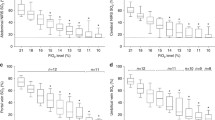Abstract
Background
Tension, ischemia, and technical error are factors leading to anastomotic complications such as leak, stricture, and ulceration with bleeding. Currently, surgeons evaluate tissue ischemia without any simple routine measurement technique. A new tissue surface probe, T-Stat 303, provides continuous measurement of tissue hemoglobin oxygen saturation (StO2) and may have clinical utility for intraoperative assessment of blood flow in areas of surgical anastomosis. This pilot study aimed to determine local StO2 during gut stapling using various staple sizes for the purpose of assessing the tool’s ability to measure changes and the reproducibility of those changes with stapling.
Methods
Measurements were made in nine anesthetized adult swine during laparotomy. Various staple heights were used to transect small bowel and colon. Serosal and mucosal surface measurements were obtained at baseline and on each side of the transection using the T-Stat device adjacent to the staple line and 2 cm away from it.
Results
Both small bowel and colon mucosal StO2 adjacent to the staple line showed significant ischemia compared with baseline (p < 0.001) and 2 cm away from the staple line (p < 0.001) using all staple heights. The serosa of both small bowel and colon adjacent to the staple line was not significantly different from baseline serosa (p > 0.11) except when the grey stapler was used (baseline, 58 ± 6.6 vs. staple line, 51 ± 15.1; p = 0.022). The baseline mucosa of the small bowel and colon did not differ from mucosa 2 cm away from the staple line (p > 0.08). The small bowel serosa 2 cm away from the staple line did not differ from baseline mucosa, whereas the colon serosa 2 cm away significantly increased after stapling compared with baseline mucosa (p < 0.012). No statistically significant StO2 difference was found between the various staple load sizes.
Conclusion
Mucosal ischemia occurs after gastrointestinal stapling and is not affected by various staple heights. The T-Stat probe provides a real-time method for assessment of gut ischemia by surgeons during surgical procedures.





Similar content being viewed by others
References
Almahmeed T, Gonzalez R, Nelson L, Haines K, Gallagher S, Murr M (2007) Morbidity of anastomotic leaks in patients undergoing Roux-en-Y gastric bypass. Arch Surg 142:954–957
Fernandez A, DeMaria E, Tichansky D, Kellum J, Wolfe L, Meador J, Sugerman H (2004) Experience with over 3,000 open and laparoscopic bariatric procedures. Surg Endosc 18:193–197
Benaron D, Parachikov I, Friedland S, Soetikno R, Brock-Utne J, van der Starre P, Nezhat C, Terris M, Maxim P, Carson J, Razavi M, Gladstone H, Fincher E, Hsu C, Clark L, Cheong W, Duckworth J, Stevenson D (2004) Continuous, noninvasive, and localized microvascular tissue oximetry using visible light spectroscopy. Anesthesiology 100:1469–1475
Nagashima Y, Yada Y, Hattori M, Sakai A (2000) Development of a new instrument to measure saturation and total hemoglobin volume in local skin by near-infrared spectroscopy and its clinical application. Int J Biometeorol 44:11–19
Podbregar M, Mozina H (2007) Skeletal muscle oxygen saturation does not estimate mixed venous saturation in patients with severe left heart failure and additional severe sepsis or septic shock. Crit Care 11:R6
Friedland S, Benaron D, Coogan S, Sze D, Soetikno R (2007) Diagnosis of chronic mesenteric ischemia by visible light spectroscopy during endoscopy. Gastrointest Endosc 65:294–300
Karliczek A, Benaron D, Baas P, van der Stoel A, Wiggers T, van Dam G (2007) Reflectance spectrometry as intraoperative assessment of perfusion in rectal anastomosis, a feasibility study (abstract). Eur Surg Res 39(Suppl 1):O.025
Friedland S, Soetikno R, Benaron D (2004) Reflectance spectrophotometry for the assessment of mucosal perfusion in the gastrointestinal tract. Gastrointest Endosc Clin North Am 14:539–553
Haisjackl M, Luz G, Sparr H, Germann R, Salak N, Friesenecker B, Deusch E, Meusburger S, Hasibeder W (1997) The effects of progressive anemia on jejunal mucosal and serosal tissue oxygenation in pigs. Anesth Analg 84:538–544
Germann R, Haisjackl M, Hasibeder W, Sparr H, Luz G, Plattner R, Pernthaler H, Friesenecker B, Falk M (1994) Dopamine and mucosal oxygenation in the porcine jejunum. J Appl Physiol 77:2845–2852
Acknowledgments
The authors offer special thanks to Mr. Mike Lowe, Ms. Ianthia Parker, and Mr. George Quick, Laboratory Technicians at the Duke University Medical Center.
Author information
Authors and Affiliations
Corresponding author
Rights and permissions
About this article
Cite this article
Myers, C., Mutafyan, G., Petersen, R. et al. Real-time probe measurement of tissue oxygenation during gastrointestinal stapling: mucosal ischemia occurs and is not influenced by staple height. Surg Endosc 23, 2345–2350 (2009). https://doi.org/10.1007/s00464-009-0342-5
Received:
Revised:
Accepted:
Published:
Issue Date:
DOI: https://doi.org/10.1007/s00464-009-0342-5




